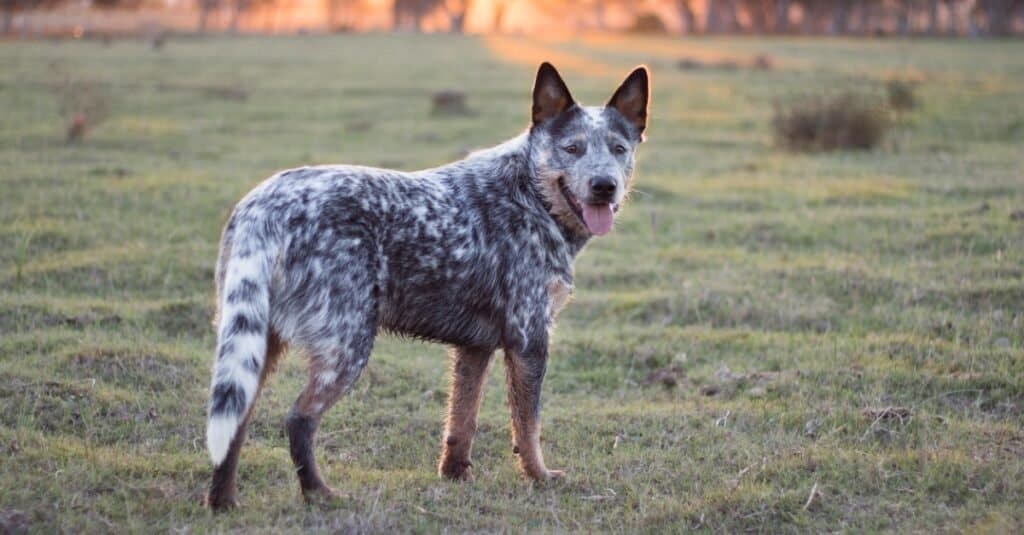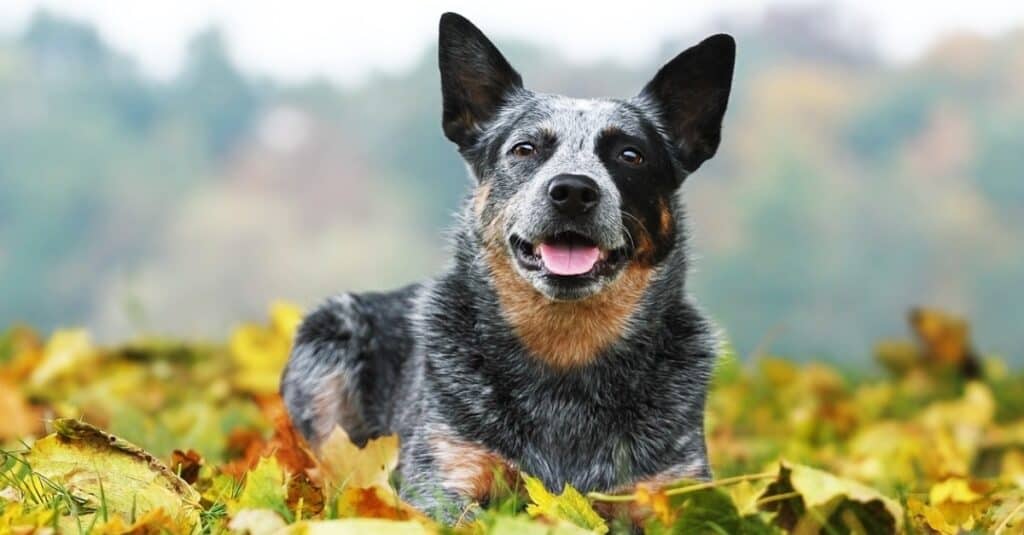The Border Collie and Australian Cattle Dog are breeds originally used for herding farm animals. You can easily tell them apart by comparing their coat types and colors. Are there any differences between them besides this? What are the things to consider if you’re trying to decide between these dog breeds?
This article will help you with this task. In the end, you will know how they differ through their appearance, personality, and skills. You’ll definitely find the answers you’re looking for.
Comparing Border Collies and Australian Cattle Dogs

| Border Collie | Australian Cattle Dog | |
|---|---|---|
| Size | Height: 18-22 inches Weight: 26-44 pounds | Height: 17-20 inches Weight: 40-55 pounds |
| Colors | Brown, red, black, white, blue, lilac; bicolored and tricolored; | Blue, grey, red, blue speckled, blue mottled |
| Coat | Double coat; thick; smooth or rough; sometimes curled | Double coat; short |
| Temperament | Curious, very intelligent, demanding, playful, energetic | Independent, extremely intelligent, loyal, active, affectionate |
| Trainability | Very persistent with their tasks; best trained with praise and clicker training | Very trainable; requires a training routine and rewarding techniques |
| Life Expectancy | 12-15 years | 13-15 years |
| Energy Levels | Very high energy level | High energy level |
4 Key Differences Between Border Collies and Australian Cattle Dogs
The key differences between Border Collies and Australian Cattle Dogs are appearance, temperament, trainability, and health.
The Border Collie comes from the Anglo-Scottish border region, while the Australian Cattle Dog has its origins in Australia. These dogs are herding dog breeds, so they are happy to learn and execute new tasks. They are extremely intelligent, trainable, playful, and energetic. However, the Border Collie and the Australian Cattle Dog have different appearances, slightly different personalities, skills, and training preferences.
Let’s study the key differences to help you understand these dog breeds better.
Border Collie vs Australian Cattle Dog: Appearance

Australian Cattle Dogs have two variations- the Blue Heeler and the Red Heeler.
©iStock.com/Madelein_Wolf
Both breeds are approximately the same size, varying between 17 and 22 inches. The Border Collie weighs around 15 pounds less than the Australian Cattle Dog.
The Border Collie has longer and thicker hair. It can be smooth, rough, or sometimes curled. This is an essential factor to consider as this breed is difficult to maintain. One of this breed’s unique characteristics is its coat color. The most common pattern for a Border Collie is black and white. The pattern can include almost any color combination known to dogs, including blue, lilac, red merle, or blue merle. Some Border Collies can also have single-colored coats. Another interesting characteristic of the Border Collie is that sometimes, the eyes can be heterochromatic.
The Australian Cattle Dog has short hair and only two acceptable colors – blue and red. Hence the two variations of the Australian Cattle Dog – the Blue Heeler and the Red Heeler. They don’t actually have blue and red hair. Puppies are born with white hair, and as they grow older, black hair (for the Blue Heeler) and brown hair (for the Red Heeler) will start to blend with the white ones. These combinations give the coat a blue and red appearance. A distinct characteristic of the Australian Cattle Dog is the dark mask they have around their eyes.
Border Collie vs Australian Cattle Dog: Temperament

Border Collies develop problematic behaviors if they get bored.
©studio hoto/Shutterstock.com
Both the Border Collie and the Australian Cattle Dog are energetic dog breeds. This means they will be happy with families that have time to play with them, entertain them, and run around the house together.
The Border Collie is much more energetic, making it more prone to boredom and destructive behavior.
The Border Collie is also more affectionate and friendly. It is not as independent as the Australian Cattle Dog and will often suffer if left alone for a long time. Border Collies can develop problematic behaviors if they get bored, such as barking, digging, chasing cars, children, or other pets. The Border Collie is much more adaptable, making it friendlier around strangers.
In comparison, the Australian Cattle Dog is much more independent, more cautious with strangers, and has a difficult time adapting to new scenarios. If the owner starts training them from an early age to socialize with people and help them adapt to new places, sounds, or sights, the Australian Cattle Dog will find it easier to get used to people outside their household. This will also prevent problematic behaviors, including nipping and biting.
Border Collie vs Australian Cattle Dog: Trainability

Australian Cattle Dogs require a rigorous training routine.
©iStock.com/Carmelka
The Border Collie and the Australian Cattle Dog are herding dog breeds. It’s natural for them to learn and execute commands. They are also rapid learners.
The Border Collie is highly persistent when it comes to learning new tasks. Praise and clicker training can help during training sessions. The Border Collie is considered a pet that needs constant mental and physical stimulation. A strict training schedule will help them use their energy in a positive and useful way.
The Australian Cattle Dog is a more independent breed. This means that they require a rigorous training routine. If a training session isn’t on time, it’s likely that they won’t do what they’re told. Other than that, this dog breed is extremely intelligent and willing to learn new things.
Border Collie vs Australian Cattle Dog: Health and Life Expectancy

Border Collies live an average of 12-15 years.
©Lucia Horvath Photography/Shutterstock.com
The Border Collie and the Australian Cattle Dog are generally healthy breeds. The excellent health of a puppy is guaranteed by a good breeder who provides you with health certificates for the parents. A study on Inherited Sensory and Autonomic Neuropathy in a Border Collie demonstrates how important it is for you to check how healthy the puppy’s parents are.
The best way to take care of your puppy or grown pet is to schedule regular check-ups with the vet.
The primary genetic diseases for the Border Collie are collie eye anomaly and epilepsy. Hip or elbow dysplasia, progressive retinal atrophy, or deafness can also affect the Border Collie. The average lifespan of this breed is 12 to 15 years, but some can live up to 18 years.
The Australian Cattle Dog can also develop hip and elbow dysplasia, progressive retinal atrophy, and deafness. The average lifespan of this breed is 13 to 15 years, but some can live much longer.
The photo featured at the top of this post is © BIGANDT.COM/Shutterstock.com
Ready to discover the top 10 cutest dog breeds in the entire world?
How about the fastest dogs, the largest dogs and those that are -- quite frankly -- just the kindest dogs on the planet? Each day, AZ Animals sends out lists just like this to our thousands of email subscribers. And the best part? It's FREE. Join today by entering your email below.
Thank you for reading! Have some feedback for us? Contact the AZ Animals editorial team.






